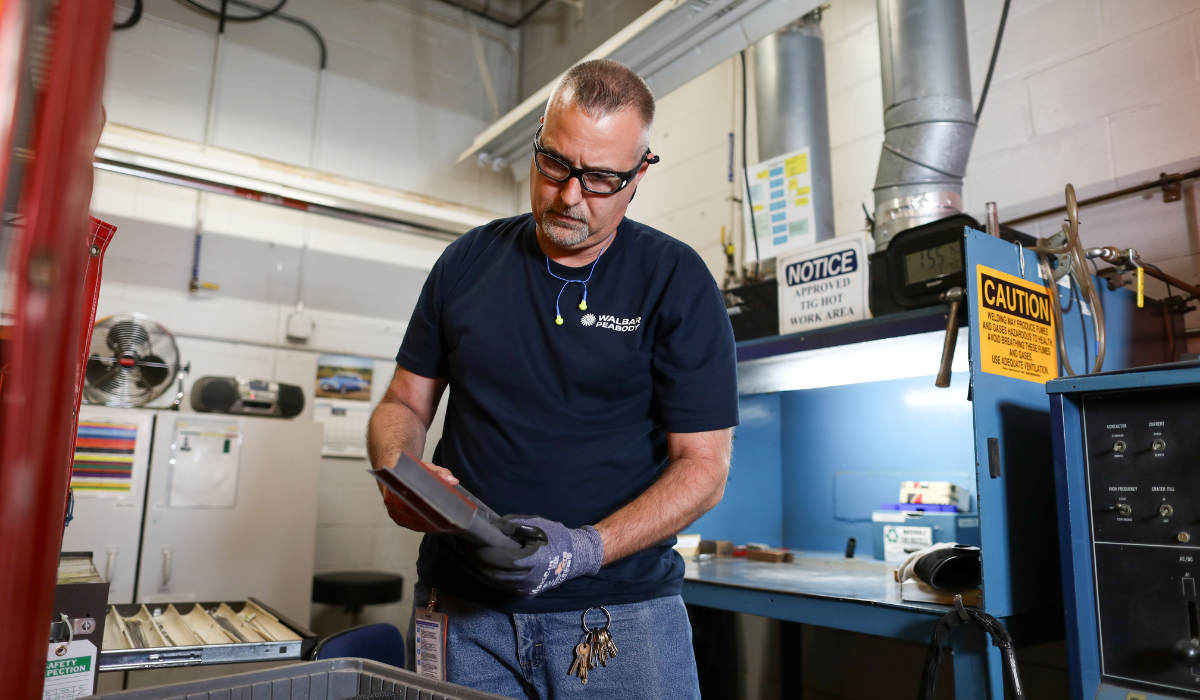The aerospace industry constantly evolves and adapts to the latest technology, which keeps our work exciting! With the new addition of a 3D scanner to our facility, we thought it was the perfect time to explore this technology and its impact on maintenance, repair, and overhaul (MRO). So, we sat down with Robert Jurcic, MRO Engineering Lead, and Bethany Folchi, Manufacturing Engineer, to discuss 3D scanning’s role in MRO and how Walbar Peabody is leveraging it.
In our world, 3D scanning can be instrumental in creating models for designing fixtures and tooling to enhance efficiency and safety. While it’s more commonly used for inspection, the technology could potentially aid the creation of CAD models for manufacturing.
To that end, our engineers have been focused on scanning as many parts in our capabilities as possible, which we’ll use to create more projects and improve processes. Read on to learn more about 3D scanning’s impact and how we’re incorporating it into our operations.

The Crucial Role of 3D Scanning in MRO
Robert is not only our MRO Engineering Lead—he’s a licensed machinist by trade who has cultivated a robust career in manufacturing and engineering, transitioning from hands-on expertise to leadership roles. In his current role, Robert spearheads initiatives to drive efficiency and innovation.
Robert’s mission at Walbar Peabody is to bring new technologies and process improvements, reduce turnaround time (TAT), and improve safety through new technologies, tools, and fixtures. Fortunately, 3D scanning offers a solution for creating models and improving tooling and fixtures. We can then release these models to the floor team, allowing them to do their jobs better, more efficiently, and more safely.

As Robert explains, some of our drawings are incomplete. Even with complete drawings, this manual process entails reverse engineering the drawings to create a CAD library, which is very time-consuming. Simply put, 3D scanning is faster than traditional manual methods.
Once we have the scanned models, we can start to build with the comprehensive part specifications and requirements. “You can actually create your part flow digitally,” Robert says. “Instead of writing it down on a piece of paper, scratching your head, you have a visual representation of what it’s supposed to look like—not only for part flow but for part manufacturing as well.”
3D scanning is also key for machining and creating accurate fixtures. Our experienced machinist knows what to do but needs the proper CAD model to optimize operations. Without it, we can’t design the precise fixtures necessary to hold parts securely and accurately during machining. This prevents us from combining operations and improving efficiency.
As for his view on 3D scanning in MRO, Robert notes it’s more prevalent in inspection. 3D scanners are highly accurate and can measure the parts for you, representing the part precisely. This technology eliminates manual inspection and the inconsistencies that come with it.
Implementing 3D Scanning at Walbar Peabody
Manufacturing Engineer Bethany brings experience from other Collins Aerospace facilities, focusing heavily on optimizing Walbar Peabody’s processes, workflow, and quality control.
Bethany has also been instrumental in implementing our new 3D scanner. “The effort was to 3D scan as many parts or hardware that we repair as possible. Those files will be used to create more projects and process improvements,” she explains.
Bethany notes that these improvements would include easier and more accurate manipulation, dimensioning, and fixture design thanks to having digital CAD models, reiterating Robert’s point about decreasing our TAT and cycle time.

“I worked with operations to get the different kinds of parts we do,” Bethany says. “I wanted to encompass everything that we do so that we could have that inventory of files to use in the future.” Over her few weeks on the project, Bethany scanned about 40 parts from our main product lines, including nozzles, blades, vein rings, and air seals (also known as barrier outer air seals or BOAs).
Additionally, Bethany points out that 3D scanning will allow us to address the issue of over-benching through improved fixturing. Currently, many of our repair processes are manual, leading to over-benching on parts like the BOAs. We’ll use the 3D scanner to create a fixture to hold the part in place, reducing the amount of manual work and standardizing our benching process, which should prevent errors and over-adjustments.
The Future of 3D Scanning in Aerospace MRO
Walbar Peabody strives toward automation alongside the quality team to align processes, ensure accuracy, and streamline processes. With our commitment to innovation and continuous improvement, this automation will play a significant role in our future capabilities by:
- Improving efficiency and reducing TAT
- Enhancing accuracy and consistency in measurements and inspections
- Strengthening fixture and tooling design
- Increasing shop floor safety
- Minimizing reliance on manual processes
We’re excited to see how 3D scanning transforms our facility and enables us to deliver the best outcomes for clients!
Interested in learning more about how we do what we do and whether we fit your MRO needs? Contact us today for more info on our capabilities.